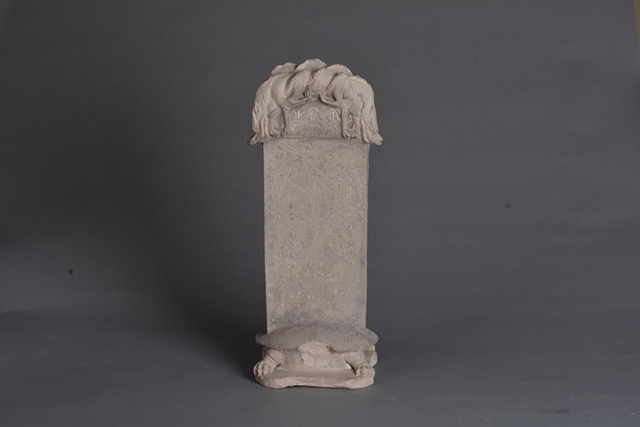|
The Tablet is 21cm long, 22cm wide, and 49cm high, weighing 8kg. It was unearthed in Qin Zhou District of Tianshui city. It consists of three parts: the head, the body, and the pedestal.
In April, 1987, the underground palace holding Buddhist relics was discovered in the construction site of Tianshui Hotel. It was of the Tang Dynasty. The excavations include two painted pottery terracotta, one gilded bronze cover of Buddhist relics container, one pottery tablet of stupa, and several fragments of pottery Buddhist relics container. The tablet is argillaceous, with six dragons spiraling together to form an arch roof. The inscriptions are seal characters. The pedestal of the tablet takes the shape of a tortoise. All the inscriptions on the pedestal are written in regular script, including 254 Chinese characters in 19 lines, among which 158 characters in 10 lines are on the front of the tablet, 52 characters in 4 lines on both sides, and 46 characters in 5 lines on the back of the tablet. The inscriptions tell the construction of the stupa as well as the time and builder. It was built by a monk named Haiyin in the 6th Year of Tianbao of Tang Dynasty.
With the development of Silk Road, Buddhism was spread eastward to Tianshui. In order to further spread Buddhism, Buddhists started to build temples in the busiest areas of large cities, making the temples public places. The stupa was built to hold the Buddhist relics and to show the importance of temples.
In the 22nd Year of Kai Yuan of Tang Dynasty, Qinzhou city was destroyed so badly in an earthquake that the government had to be moved to Cheng Ji, which is today's Tianshui. In the sixth year of Tianbao (747 AD), Haiyin, a Buddhist from Yong'an Temple in Tianshui county, constructed the underground palace to preserve the relics of Sakyamuni, the founder of Buddhism.
|

